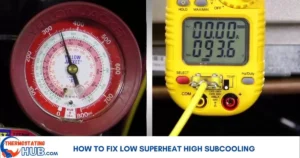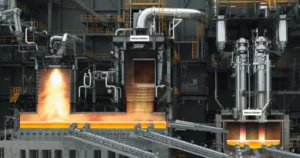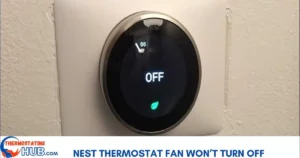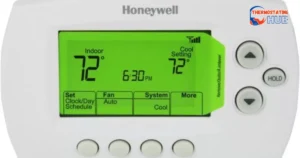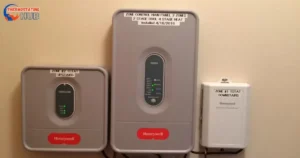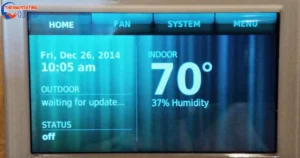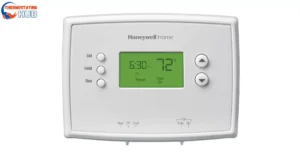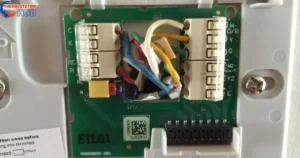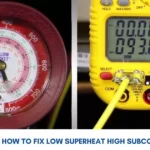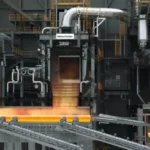If your Ecobee isn’t cooling to the desired temperature, don’t stress! This guide covers the common issues hindering your Ecobee thermostat from reaching the set temperature and solutions to resolve these issues.
Usually, your Ecobee is not cooling to the set temperature because of an active air-air exchange. This exchange operates during the winter, pulling fresh air from outside and expelling damp indoor air.
However, if you don’t have an air-air exchanger and still face cooling issues with your Ecobee or any other thermostat, there are other potential causes. The table below outlines why a thermostat might not cool to the set temperature and offers potential fixes.
Remember, regular maintenance and checking for these issues can ensure your thermostat functions smoothly!
Possible reasons for an Ecobee not cooling to set temperature and fixes
| Possible Cause | Main Fix |
| The air exchanger turned on | Turn off the air exchanger |
| Leaky ductwork | Inspect and seal off leaks |
| A thermostat that needs a reset | Reset/reboot your thermostat |
| Low refrigerant | Recharge the AC system with freon |
| Inappropriate thermostat location | Ensure the thermostat is in an ideal location |
| Dirty air filters | Clean or replace air filters |
| Automatic schedules | Remove and deactivate auto schedules |
Now, let’s delve into the troubleshooting details for addressing this issue.
Pro Tip: Regularly maintaining your HVAC system ensures optimal performance. Check filters, thermostat settings, and potential leaks to avoid common issues.
The air exchanger turned On
An air exchanger brings fresh air inside during the winter by expelling damp air outdoors. Meanwhile, an air conditioner dehumidifies and condenses the air using freon’s evaporation and condensation.
Consequently, the air conditioner eliminates moisture while the air exchanger functions oppositely.
Thus, if both the air exchanger and air conditioner are switched on simultaneously during the summer, they will essentially combat each other.
Solution
To resolve the issue, switch off the air-air exchanger and allow your thermostat to reach the desired temperature.
If your home doesn’t have an air exchanger and your ecobee isn’t cooling adequately, there might be a problem with leaky ductwork.
Pro tip: Regularly check and maintain your ductwork to ensure efficient cooling.
Read Also: Sensi Thermostat Not Turning On AC [Fixed]
Leaky ductwork
Ductwork is crucial within air conditioning setups as it helps distribute cooled air throughout your home or designated areas. Over time, these ducts might develop leaks due to exposure to extreme temperatures in uninsulated zones.
When duct systems have leaks or displacements, cooled air might escape into surrounding areas before reaching the intended vents. This escaping air can disrupt the cooling process in your home, causing your ecobee to struggle to blow cold air and achieve the desired temperature.
Pro Tip: Regularly inspect and maintain your ductwork to prevent leaks and ensure efficient cooling in your space.
Solution
If you think there might be leaks in your duct system, check it for leaks and repair any areas with leaks. If it’s challenging, consider reaching out to a local HVAC professional for assistance.
On the other hand, if your duct system is undamaged, consider resetting your thermostat.
Pro tip: Regularly checking and maintaining your duct system can help improve energy efficiency and reduce utility bills.
A thermostat that needs a reset
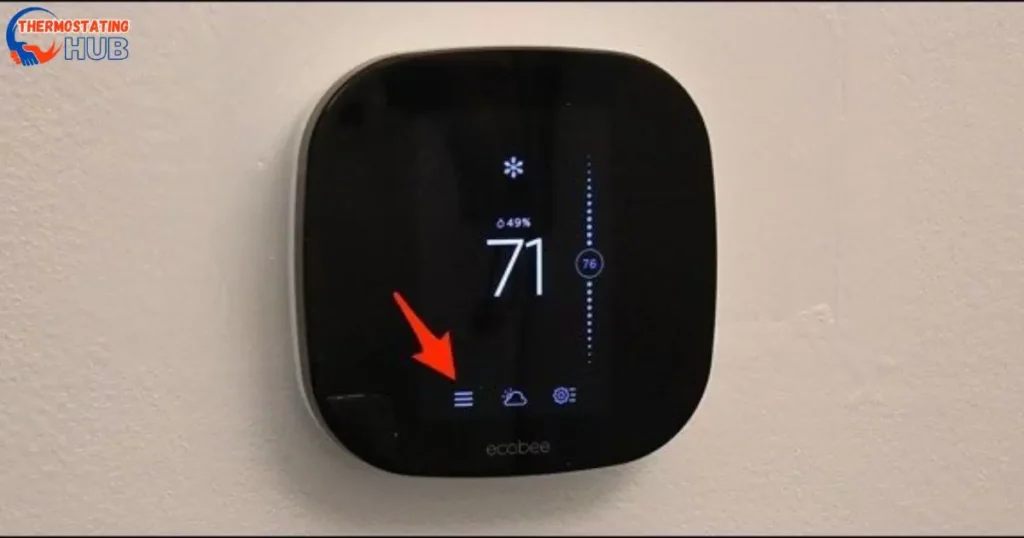
Certainly! Here’s a revised version of the provided text, following the guidelines
Sometimes, small glitches in the thermostat’s firmware (software used) can lead to heating and cooling problems. The best fix is to reboot your thermostat. If rebooting doesn’t solve the issue, you may need to reset it.
Caution: Resetting your thermostat might delete your programmed settings and schedules. It’s a good idea to note them down before proceeding with the reset. 🚨
Pro tip: Before rebooting or resetting your thermostat, check the manufacturer’s website for specific instructions or contact their customer support for guidance tailored to your model.
Low refrigerant
When your AC system has low refrigerant, it affects cooling. If you’re a DIY enthusiast with gauges, you can check the pressure on the AC lines. Otherwise, consider seeking assistance.
If there’s a refrigerant leak, your Ecobee may not adequately cool your home or might not cool it at all.
Expert tip: Regularly check for refrigerant leaks and ensure proper maintenance to keep your AC system running efficiently.
Solution
Once you confirm a low freon charge, the initial step is to seal any leaks before recharging your system. A licensed technician can perform this task without difficulty. 😉
Pro Tip: Regular maintenance checks by professionals help identify issues like low freon charges early, ensuring efficient functioning and preventing major problems later on.
Inappropriate thermostat location
Sometimes, a thermostat may not cool to the set temperature because of its placement. When it’s in a spot affected by wind or doesn’t accurately reflect your home’s temperature, it can cause reading discrepancies for your ecobee.
Pro tip: Ensure your thermostat is installed away from drafts or direct sunlight for more accurate temperature readings.
Solution
Make sure to place your thermostat in the central part of your home, ideally in the living room, for the best temperature control. Aim for an ideal height between 52 to 60 inches off the floor for installation.
Pro tip: Placing the thermostat in a central location and at an optimal height ensures accurate temperature readings, resulting in better control of your home’s climate.
Dirty air filters
If your AC isn’t cooling properly, it might be due to dirty air filters. Have you recently washed or replaced your AC filters? Dirty filters are known to hinder efficient cooling and can lead to various issues within your AC system.
Pro Tip: Regularly check and clean or replace your AC filters every one to three months to ensure optimal performance and prevent potential problems.
Solution
If you can’t recall the last time you changed the air filters, now’s the perfect moment to take action. Go over to the furnace or air handler and inspect the air filter.
Hold the filter against the light. If it’s tough to see the light through it, it’s time for a replacement.
Dirty air filters might cause your ecobee thermostat not to cool to the desired temperature. Changing the filter can potentially solve this issue.
Pro Tip: Regularly replacing air filters maintains healthy indoor air quality and ensures the efficient functioning of your HVAC system, saving you money in the long run.
Automatic schedules
Certain Ecobee models can stop cooling to particular temperatures if there are active schedules on the thermostat.
To eliminate the schedules, you can turn off automatic schedules. Another way to remove schedules is by resetting your thermostat.
Pro Tip: Regularly reviewing and adjusting your thermostat settings can help optimize energy usage, saving energy and costs in the long run.
Effective Solutions: Ecobee Not Cooling to Set Temperature
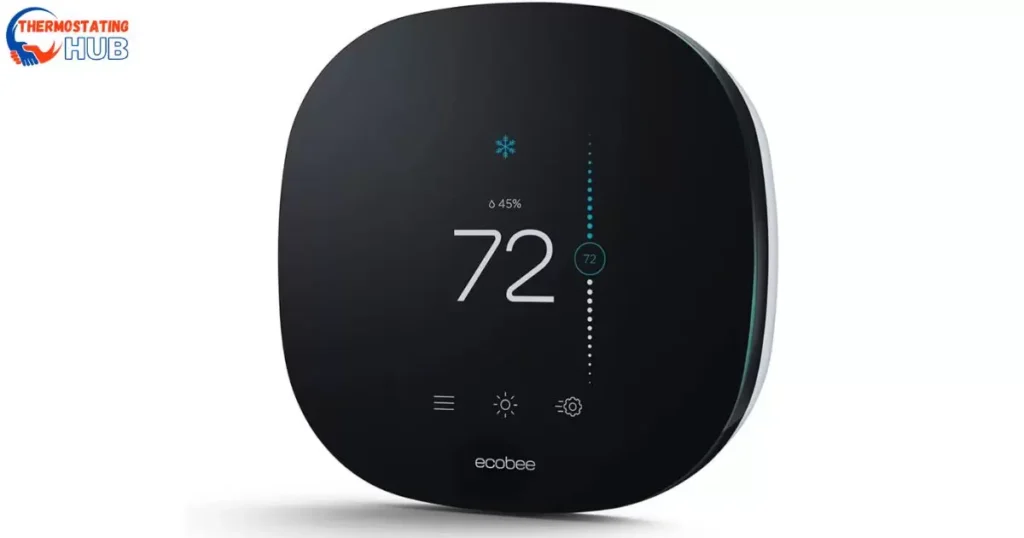
When your Ecobee isn’t cooling to the set temperature, a few troubleshooting steps might help resolve the issue.
First, check if the Ecobee thermostat is set to cool mode and that the desired temperature is correctly programmed. Ensure that the cooling schedule is active and not overridden by any other settings.
Next, examine the air vents to confirm they aren’t obstructed by furniture or objects. Blocked vents can restrict airflow, impacting the cooling efficiency. Ensure the air filters are clean; dirty filters can hinder proper airflow and affect cooling performance. Replace them if necessary.
Verify if the Ecobee thermostat is communicating effectively with your HVAC system. Check if the wiring and connections are secure. Resetting the thermostat or power cycling your HVAC system helps re-establish proper communication.
Additionally, ensure that the room temperature sensor isn’t affected by external factors such as sunlight or drafts. If the sensor is placed in a location where it’s influenced by such conditions, consider relocating it for more accurate temperature readings.
If these steps don’t resolve the issue, contacting Ecobee’s customer support or a professional HVAC technician for further assistance might be necessary to diagnose and fix any underlying issues with the system.
Pros and Cons of Temperature Control Issues
| Pros of Ecobee | Cons of Ecobee |
| 1. Smart Features: | 1. Temperature Discrepancies: |
| Ecobee offers smart technology | Some users report temperature |
| allowing remote control and | inconsistencies between the |
| scheduling through apps. | set temperature and actual room |
| temperature. | |
| 2. Energy Savings: | 2. Sensor Dependency: |
| Its smart sensors adjust | The system heavily relies on |
| heating/cooling based on | additional sensors for accurate |
| occupancy, potentially | temperature control, which may |
| reducing energy costs. | increase the overall cost. |
| 3. Compatibility: | 3. Complex Setup: |
| Works well with various HVAC | Installation might be challenging |
| systems and smart home devices. | for some users, requiring |
| for systems and smart home devices. | |
| 4. User-Friendly Interface: | 4. Software Glitches: |
| Easy-to-use interface and | Some users experience occasional |
| intuitive app design for | software bugs or connectivity |
| seamless control. | issues affecting performance. |
Expert Tips to Fix Cooling Problems and Prevent Future Issues
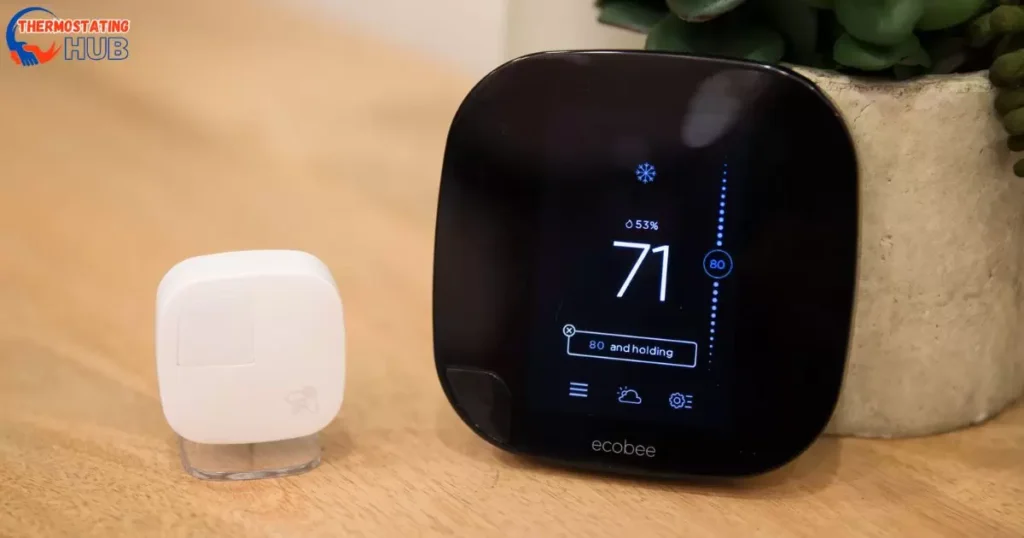
Mastering Ecobee means having the knack to troubleshoot cooling issues effortlessly. First, check your thermostat settings to ensure they’re optimized for cooling. Ensure your schedule aligns with your comfort needs and that your Ecobee system is set to ‘Cool’ mode.
Check the air filters regularly – clogged filters can hinder airflow, affecting cooling efficiency. Consider the placement of your sensors; they play a crucial role in temperature regulation, so ensure they’re in optimal locations for accurate readings.
Preventing future cooling problems involves regular system maintenance. Schedule periodic HVAC inspections to ensure everything is in working order. Keep an eye on your home’s insulation; proper insulation can significantly impact cooling efficiency.
Explore your Ecobee’s advanced settings for additional customization options – features like Smart Recovery and Follow Me mode can enhance your system’s efficiency. Lastly, consider integrating smart home devices for better control and energy savings. Mastering your Ecobee system takes time, but with these expert tips, you’ll troubleshoot issues and pave the way for efficient, hassle-free cooling.
FAQs
Why is my ecobee not reaching set temperature?
Your ecobee might not reach the set temperature due to various reasons such as improper thermostat settings, a malfunctioning HVAC system, dirty air filters, or incorrect scheduling. Check your settings, ensure the system works correctly, and consider cleaning or replacing air filters.
Why is my AC not cooling to the thermostat setting?
Several factors could cause your AC to not cool properly, including low refrigerant levels, dirty coils, a malfunctioning compressor, or inadequate airflow. It’s advisable to check for these issues, clean components if necessary, and seek professional HVAC assistance if problems persist.
Why isn’t ecobee cooling?
If your ecobee isn’t cooling, there might be issues with the thermostat settings, incorrect temperature settings, a malfunction in the HVAC system, or an issue with the cooling equipment itself. Check the settings, ensure the system is set to cool mode, and troubleshoot any potential issues with the HVAC system or the ecobee device.
How do I force my ecobee to cool?
To force your ecobee to cool, ensure it is set to cool mode, and the target temperature is lower than the current room temperature. You can adjust settings directly on the ecobee thermostat or through the associated app. If the cooling doesn’t start, check for any error messages on the ecobee screen or consult the user manual for troubleshooting steps. If problems persist, contact ecobee support or an HVAC professional for assistance.
Final thought
Hopefully, you’ve been able to fix the issue with your ecobee not cooling. If not, consider contacting a local licensed technician for further assistance.
Pro tip: Regular cooling system maintenance can help prevent future issues. Schedule routine check-ups to keep it running smoothly.

I’m Nicholas Clark, your HVAC guide at thermostatinghub.com. More than just a writer, I’m your go-to guy for solving heating and cooling mysteries. My blog is a storytelling haven where we unravel HVAC tales together. Let’s turn your comfort queries into stories of warmth and coolness!
![Ecobee Not Cooling To Set Temperature [Solved]](https://thermostatinghub.com/wp-content/uploads/2023/12/ecobee-not-cooling-to-set-temperature.webp)


